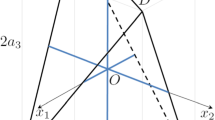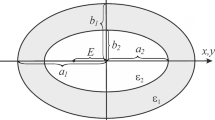Abstract
The inertial characteristics of celestial bodies can be calculated using their triangle partitions based on photometric observations. Such partitions can be refined along with the accumulation of necessary information. In this regard, the question arises to what extent the approximations of the inertial characteristics of celestial bodies, in particular, the approximations of the components of the Euler–Poinsot tensor of different orders, are susceptible to the choice of such partitions. Such components enter into the expansion of the gravitational potential in harmonic polynomials. In this paper, for some small celestial bodies, a comparison of such coefficients is carried out as coarse partitions are replaced with finer ones.
Similar content being viewed by others
Notes
†December 9, 2019.
REFERENCES
P. Appell, Leçons sur l’attraction et la fonction potentielle: professées à la Sorbonne en 1890–1891 (G. Carrie, Paris, 1892).
H. Poincaré, Théorie du potentiel newtonien: Leçons professées à la Sorbonne pendant le premier semestre 1894–1895 (Gauthier-Villars, Paris, 1899).
G. N. Duboshin, Theory of Gravitation (Fizmatlit, Moscow, 1961) [in Russian].
L. N. Sretenskii, Theory of Newtonian Potentials (Gostekhizdat, Moscow, 1946) [in Russian].
V. V. Beletskii, Motion of an Artificial Satellite about Its Center of Mass (Nauka, Moscow, 1965; Israel Program for Scientific Translations, 1966).
G. N. Duboshin, Celestial Mechanics: Basic Problems and Methods (Fizmatlit, Moscow, 1968; Defense Tech. Inf. Center, Fort Belvoir, 1969).
V. A. Antonov, E. I. Timoshkova, and K. V. Kholshevnikov, Introduction to the Theory of Newtonian Potentials (Fizmatlit, Moscow, 1988) [in Russian].
G. N. Doubochine, “Sur le développement de la fonction des forces dans le problème de deux corps finis,” Celestial Mech. 14, 239–281 (1976).
A. R. Dobrovolskis, “Inertia of any polyhedron,” Icarus 124 (2), 698–704 (1996).
B. Mirtich, “Fast and accurate computation of polyhedral mass properties,” J. Graphics Tools 1 (2), 31–50 (1996).
F. A. Sludskii, Master’s Dissertation in Astronomy (Universitetskaya (Katkov K), Moscow, 1863).
R. A. Werner, “The gravitational potential of a homogeneous polyhedron or don’t cut corners,” Celestial Mech. Dyn. Astron. 59 (3), 253–278 (1994).
R. A. Werner and D. J. Scheeres, “Exterior gravitation of a polyhedron derived and compared with harmonic and mascon gravitation representations of asteroid 4769 Castalia,” Celestial Mech. Dyn. Astron. 65 (3), 313–344 (1996).
A. A. Burov and V. I. Nikonov, “Computation of attraction potential of asteroid (433) Eros with an accuracy up to the terms of the fourth order,” Dokl. Phys. 65, 164–168 (2020).
V. I. Nikonov, Gravitational Fields of Small Celestial Bodies (Belyi Veter, Moscow, 2020) [in Russian].
A. A. Burov and V. I. Nikonov, “Inertial characteristics of higher orders and dynamics in a proximity of a small celestial body,” Russ. J. Nonlinear Dyn. 16 (2), 259–273 (2020).
R. A. Werner, “Spherical harmonic coefficients for the potential of a constant-density polyhedron,” Comput. Geosci. 23 (10), 1071–1077 (1997).
D. Liao-McPherson, W. D. Dunham, and I. Kolmanovsky, “Model predictive control strategies for constrained soft landing on an asteroid,” AIAA/AAS Astrodynamics Specialist Conference, September 13–16, 2016, Long Beach, California (2016).
P. C. Thomas, J. Joseph, B. Carcich, et al., “Eros: Shape, topography, and slope processes,” Icarus 155 (1), 18–37 (2002).
M. T. Zuber, D. E. Smith, A. F. Cheng, et al., “The shape of 433 Eros from the NEAR-Shoemaker laser rangefinder,” Science 289, 2097–2100 (2000).
J. K. Miller, A. S. Konopliv, P. G. Antreasian, et al., “Determination of shape, gravity, and rotational state of asteroid 433 Eros,” Icarus 155 (1), 3–17 (2002).
T. L. Farnham, “Shape model of asteroid 21 Lutetia, RO-A-OSINAC/OSIWAC-5-LUTETIA-SHAPE-V1.0” (NASA Planetary Data System, 2013).
C. Capanna, L. Jorda, P. Gutierrez, and S. Hviid, “MSPCD SHAP2 Cartesian plate model for comet 67P/C-G 6K PLATES, RO-C-MULTI-5-67P-SHAPE-V1.0:CG_MSPCD_SHAP2_006K_CART” (NASA Planetary Data System and ESA Planetary Science Archive, 2015).
C. Capanna, L. Jorda, P. Gutierrez, and S. Hviid, “MSPCD SHAP2 Cartesian plate model for comet 67P/C-G 12K PLATES, RO-C-MULTI-5-67P-SHAPE-V1.0:CG_MSPCD_SHAP2_012K_CART” (NASA Planetary Data System and ESA Planetary Science Archive, 2015).
C. Capanna, L. Jorda, P. Gutierrez, and S. Hviid, “MSPCD SHAP2 Cartesian plate model for comet 67P/C-G 24K PLATES, RO-C-MULTI-5-67P-SHAPE-V1.0:CG_MSPCD_SHAP2_024K_CART” (NASA Planetary Data System and ESA Planetary Science Archive, 2015).
C. Capanna, L. Jorda, P. Gutierrez, and S. Hviid, “MSPCD SHAP2 Cartesian plate model for comet 67P/C-G 48K PLATES, RO-C-MULTI-5-67P-SHAPE-V1.0:CG_MSPCD_SHAP2_048K_CART” (NASA Planetary Data System and ESA Planetary Science Archive, 2015).
C. Capanna, L. Jorda, P. Gutierrez, and S. Hviid, “MSPCD SHAP2 Cartesian plate model for comet 67P/C-G 98K PLATES, RO-C-MULTI-5-67P-SHAPE-V1.0:CG_MSPCD_SHAP2_098K_CART” (NASA Planetary Data System and ESA Planetary Science Archive, 2015).
X. Wang, Y. Jiang, and Sh. Gong, “Analysis of the potential field and equilibrium points of irregular-shaped minor celestial bodies,” Astrophys. Space Sci. 353 (1), 105–121 (2014).
Y. Jiang, H. Baoyin, and H. Li, “Collision and annihilation of relative equilibrium points around asteroids with a changing parameter,” Mon. Not. R. Astron. Soc. 452 (4), 3924–3931 (2015).
Y. Jiang and H. Baoyin, “Annihilation of relative equilibria in the gravitational field of irregular-shaped minor celestial bodies,” Planet. Space Sci. 161, 107–136 (2018).
S. Aljbaae, T. G. G. Chanut, V. Carruba, et al., “The dynamical environment of asteroid 21 Lutetia according to different internal models,” Mon. Not. R. Astron. Soc. 464 (3), 3552–3560 (2017).
R. A. Werner, “The solid angle hidden in polyhedron gravitation formulations,” J. Geodesy 91, 307–328 (2017).
A. P. Markeev, Libration Points in Celestial Mechanics and Astrodynamics (Fizmatlit, Moscow, 1978) [in Russian].
V. K. Abalakin, “On the stability of libration points of a rotating gravitating ellipsoid,” Byull. Inst. Teor. Astron. 6 (8), 543–549 (1957).
Yu. V. Batrakov, “Periodic motion of a particle in the gravitational field of a rotating triaxial ellipsoid,” Byull. Inst. Teor. Astron. 6, 524–542, (1957).
S. G. Zhuravlev, “Instability of libration points of a rotating gravitating ellipsoid,” in Collected Research Papers of Postgraduate Students (Univ. Druzhby Narodov, Moscow, 1968), No. 1, pp. 169–183 [in Russian].
S. G. Zhuravlev, “Stability of the libration points of a rotating triaxial ellipsoid,” Celestial Mech. 6, 255–267 (1972).
S. G. Zhuravlev, “About the stability of the libration points of a rotating triaxial ellipsoid in a degenerate case,” Celestial Mech. 8 (1), 75–84 (1973).
S. G. Zhuravlev, “Stability of the libration points of a rotating triaxial ellipsoid in the three-dimensional case,” Astron. Zh. 51 (16), 1330–1334 (1974).
I. I. Kosenko, “On libration points near a gravitating and rotating triaxial ellipsoid,” J. Appl. Math. Mech. 45 (1), 18–23 (1981).
I. I. Kosenko, “Libration points in the problem of a triaxial gravitating ellipsoid: Geometry of the stability domain,” Kosm. Issled. 19 (2), 200–209 (1981).
I. I. Kosenko, “Nonlinear analysis of the stability of the libration points of a triaxial ellipsoid,” J. Appl. Math. Mech. 49 (1), 17–24 (1985).
I. I. Kosenko, “On a power series expansion of the gravitational potential of an inhomogeneous ellipsoid,” J. Appl. Math. Mech. 50 (2), 142–146 (1986).
I. I. Kosenko, “On the stability of points of libration of an inhomogeneous triaxial ellipsoid,” J. Appl. Math. Mech. 51 (1), 1–5 (1987).
Funding
The research by V.I. Nikonov was supported by a Russian Federation Presidential grant (no. MK-1712.2019.1) for the state support of scientific research of young Russian scientists: candidates and doctors of sciences, and was supported in part by the Russian Foundation for Basic Research (project no. 18-01-00335).
Author information
Authors and Affiliations
Corresponding authors
Additional information
Translated by E. Chernokozhin
APPENDIX: TABLES WITH CALCULATION RESULTS
APPENDIX: TABLES WITH CALCULATION RESULTS
Rights and permissions
About this article
Cite this article
Burov, A.A., Nikonov, V.I. Sensitivity of the Euler–Poinsot Tensor Values to the Choice of the Body Surface Triangulation Mesh. Comput. Math. and Math. Phys. 60, 1708–1720 (2020). https://doi.org/10.1134/S0965542520100061
Received:
Revised:
Accepted:
Published:
Issue Date:
DOI: https://doi.org/10.1134/S0965542520100061




